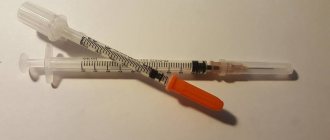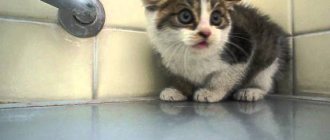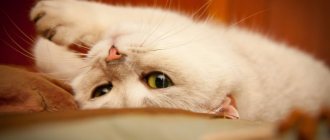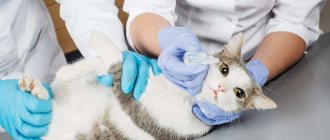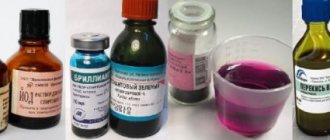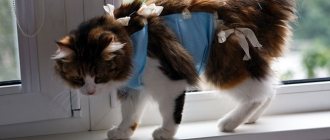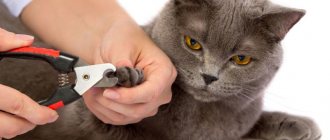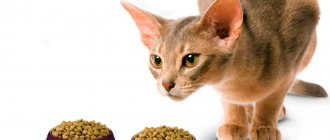Do you live in a region with hot summers and have a pet? If you don't have air conditioning, you're probably worried about your cat getting heatstroke. You probably have a lot of questions swarming in your head: what could happen during the day while you are not at home? Will your furry beauty sweat—or suffer? Is she hot?
Luckily, there are a few things you can do yourself to keep your home cool enough for your pet.
How to tell if your cat is overheated
If “overboard” is 30+, and the apartment is stuffy, watch your pet. There are signs that show that he cannot do without your help:
- breathes quickly, sticking out his tongue like a dog;
- does not drink for more than 6 hours in a row;
- lies in one position;
- does not respond to calls and external stimuli;
- trembles;
- pupils dilated;
- the heart beats faster than usual;
- nose is dry and hot.
Have you noticed at least a few symptoms from the list? Start providing first aid.
The cat is alone in the apartment
If the owners are forced to leave their pet alone for the whole day in a stuffy apartment, they are obliged to provide the cat with comfortable conditions in which the animal can more easily tolerate the heat:
- give the animal access to the bathroom;
- provide the cat with a sufficient amount of drinking water (put out not one bowl, but several);
- ventilate the apartment;
- leave a damp towel on the cat bed;
- hang wet sheets and towels in the apartment.
But if the room is too stuffy, the method of humidifying the air with wet towels will not work, since humid and hot air can negatively affect the functioning of the animal’s cardiovascular system.
Attention! The cat himself is able to find the most comfortable and coolest place in the apartment.
If he finds one and is escaping the heat there, do not drive the animal away, even if its presence causes you inconvenience.
When leaving your cat alone, provide him with enough drinking water.
Quench your thirst
Basically, cats are afraid of water and don’t even drink it often - this is their physiology. And in the heat they follow their ingrained habit and simply forget to drink. Your task is to make the fluffy drink at least a sip. To do this we can:
- bring a bowl of water to the animal, wet its face and lips and thus force it to drink;
- Fill a syringe without a needle with cool water and pour 5-10 cubes into the cat’s mouth.
Both ways are good. If the cat is healthy, he will quickly return to normal. The main thing for us is to prevent dehydration. All zoos around the world are well aware of this, and in the summer heat they give predators ice with added blood.
Well, domestic cats will happily accept nutritious ice from light broth or milk.
Advice
If your cat is sweltering from the heat but flatly refuses water, give her a couple of ice cubes with 1 drop of catnip or valerian extract.
Fresh air
In hot conditions, the body urgently needs fresh air: stale apartment air, containing insufficient oxygen, will have to be inhaled more often to supply the organs. And with rapid breathing, the load on the heart and lungs increases, which is undesirable in the heat.
Based on this, the first thing to do is open the windows for ventilation. Make sure that the animal does not jump out the window. To do this, special metal mesh is placed in the window frames. Not to be confused with mosquitoes, which break through easily.
Lowering body temperature
Our best allies are water and coolness.
- Close the curtains, open the windows, or move the cat to a cooler room.
- Saturate the sponge with cold water. Wet the cat's paw pads, head and neck. You can also have a belly if you are allowed. Repeat the procedure at least once an hour.
- Cover the sufferer with a wet waffle towel. Just don’t forget to wet it every 5 minutes, otherwise the animal will receive a hot compress instead of a cooling procedure.
- Freeze water in a plastic bottle and place it next to the cat, wrapped in a cloth. This will humidify and cool the air around you.
- Direct the fan at your pet in a gentle mode. Let a light breeze blow over it.
You can combine business with pleasure. I made a “house” for my cat from two stools covered with a wet sheet, and placed a fan nearby. He adored his shelter, and only in the evening, sleepy and fresh, did he go out for dinner.
Animal behavior is an indicator of temperature conditions
In cats, behavior does not clearly illustrate heat exhaustion. The reason for this is the distribution of receptors responsible for the perception of heat or cold in the animal’s body. Confirmation that cats also get hot is their more imposing behavior in the summer and lack of mobility. A characteristic position indicating that the cat is hot and is trying to cool itself down on its own is lying on its back. It is on the stomach that the largest number of thermal receptors are located, which the cat naturally cools during the heat. Playfulness appears in a cat if it gets rid of excess fluff, which prevents heat transfer to the environment. Grooming a cat is currently in great demand, because in addition to the aesthetic side, it also radically solves the problem of overheating of a pet. Some cats, following the tradition of fear of water, do not hesitate to lie in a cold, dry bath or sink to cool down. In the summer, less and less can you find a cat sleeping on the sofa (it’s hot), and more and more on the floor. Frequent changes in body position are additional evidence that the animal is hot. Moreover, an elongated pose indicates heat is being transferred outward, while a cat squeezed into a ball is trying to retain heat within itself. Observation of the habits of cats allows us to conclude that their diet undergoes a number of changes in the summer. Meat and dry food are in less demand, and greater preference is given to drink and fish.
We feed correctly
On hot days, your cat may refuse to eat. There is no need to force feed her. The owners’ task is to make her life easier and support her strength. In some cases, it even makes sense to move away from your usual diet. Especially if the animal is on dry food.
For variety, offer your animal lighter meals:
- chilled fermented milk products;
- ground raw turkey;
- minced boiled turkey or chicken with the addition of water or stewed vegetables (zucchini, carrots);
- chilled or frozen poultry broth;
- 1 tablespoon of low-fat and not very sweet ice cream for dessert.
Most often, cats decide for themselves what is best for them to eat on a hot day. And their desires are paradoxical. For example, my Norwegian Forest Cat loved cucumbers and melon. The main thing was to think of treating him with plant delicacies.
Read more about proper nutrition in the article What to feed your cat.
Signs of overheating
Being in an open space for a long time at elevated temperatures or in a stuffy and hot room, cats can experience overheating and heatstroke. This occurs due to the fact that behavioral and physiological thermoregulatory mechanisms can no longer ensure effective heat transfer. High hyperthermia creates increased stress on:
- thermoregulatory apparatus;
- cardiovascular system;
- respiratory system;
- urinary system;
- vital centers of the brain and nervous system.
Signs of overheating in cats:
- Unusual lethargy and apathy, even to the point of fainting.
- Rapid, heavy breathing with an open mouth and protruding tongue. According to evidence from felinologists, cats, unlike dogs, open their mouths in the heat only when their hearts are working in a strained critical mode.
- Increased heart rate. This indicator can be measured by directly placing your palm on the left side of the cat's chest. The normal heart rate is from 100 to 140 beats per minute.
- Increase in body temperature to +40°C and above. In this case, the animal becomes very hot to the touch. Veterinarians measure the temperature of cats rectally using a mercury thermometer or an electronic thermometer. Normally it should be +38-39°C.
- Redness of the mucous membranes of the mouth and the white of the eyes. Sometimes hemorrhages can be seen under the eyelids.
- Brain disorders manifested by vomiting and trembling of the limbs.
Consequences. The longer a cat remains in a state of hyperthermia, the more serious the consequences for its health can be. If the animal is not provided with immediate assistance, and the body temperature continues to increase and reaches +42°C, then cardiogenic shock, irreversible changes in the heart and brain, damage to the kidney parenchyma and death of the intestinal microflora will occur. Before death, a comatose state occurs, the mucous membranes acquire a bluish tint, and the body temperature drops sharply.
Also watch the video on how to help a cat in hot weather:
Creating a microclimate at home
It's great if you live in your own house with a garden where there are secluded shady corners. Here is a cat walking on its own, and without you, it will figure out where it is better to hide. Your task is to place bowls of water throughout the area and pour fresh water daily.
In apartments the situation is different. There during the day it is sometimes hotter than outside and stuffy. Therefore, the owner, when leaving for work, and especially leaving for the weekend, must provide his pet with a comfortable existence. Here is a list of what you need:
- Air flow due to micro-ventilation.
- Thick curtains to protect the room from sunlight.
- Fresh water and food, for this there are automatic drinkers and feeders.
- Clean toilet.
Advice
Pet stores sell cooling gel mats for animals; they keep the temperature constant between 17-25 degrees. Experience shows that animals like them, and at the same time they save them from overheating.
Article information
This article was co-authored by. Dr. Elliott, BVMS, MRCVS is a veterinarian with over 30 years of experience in veterinary surgery and the care of companion animals. She graduated from the University of Glasgow in 1987 with a degree in Veterinary Medicine and Surgery. He has been working at the same animal clinic in his hometown for over 20 years.
Categories: Cats | Cat health
In other languages:
English: Cool Your Cat Down in the Summer, Español: refrescar a tu gato en el verano, Italiano: Fare Stare Fresco il Gatto in Estate, Deutsch: Deiner Katze im Sommer Kühlung verschaffen, Português: Refrescar seu Gato no Verão, Français: rafraichir son chat pendant l'été, Bahasa Indonesia: Mendinginkan Kucing di Musim Panas, Nederlands: Je kat afkoelen in de zomer, Tiếng Việt: Hạ nhiệt cho mèo trong mùa hè, ไทย: ทำให้แมวเ ย็นลงในช่วงหน้าร้อน, 한국어: 여름 고양이 체온 내리는 법, العربية: ترطيب قطتك في الصيف, 日本語: 猫のために夏中文: 在炎炎夏日给猫咪解暑降温, Türkçe: Yazın Bir Kedi Nasıl Serinletilir
This page has been viewed 43,891 times.
Was this article helpful?
Not really
What cat breeds do not tolerate heat well?
Persians, British and exotics - they have a flat, snub-nosed muzzle and modified upper respiratory tracts. This makes breathing difficult. And thick, poorly ventilated wool can lead to overheating. It is recommended to comb them daily or cut them for the summer.
Siberian and Norwegian forest dogs - they are better off galloping across snowy expanses. Their wool is waterproof and retains heat well.
Sphynx - hairless cats can get sunburned and even get sunstroke. Therefore, it is recommended to let them out for a walk before 12 noon and after 5 pm, applying sunscreen with a minimum factor of 20, and odorless. In the evening, the cream must be removed with special wipes to allow the skin to breathe.
So if you haven’t yet decided on a breed and haven’t got a pet, take into account the climate where you live. I hope the article What breed of cats to choose for an apartment will help you make the right decision.
Signs of overheating
Overheating can be easily noticed by the animal's unusual behavior. Here are its manifestations:
- Passive behavior. Cats lie down in the heat, moving to a minimum.
- Rapid breathing. It is noticeable by the movement of the pet's chest.
- The cat licks itself thoroughly to lower its body temperature.
- Tongue stuck out. It may be an unusual burgundy color.
Checking your water balance
The biggest danger of overheating is the cat's body losing fluid. You can find out if your pet is suffering from dehydration as follows:
- Pull back the animal’s lower eyelid: if there is no moisture at the recess, it means that the water balance in the cat’s body is disturbed.
- Press down on your gums. If dehydrated, their color will become pale. In a healthy cat, when pressed, the color is very quickly restored and becomes pink.
- Pull back slightly and release the withers. The fold in the skin should immediately fall, and not remain in a compressed position for several seconds.
Important tips and do's and don'ts
Cats should be healthy even in hot weather. Try not to harm them.
- Never lock your cat in the car, even for a few minutes.
- Do not lock yourself in an apartment unattended for more than 3 days.
- Avoid sleeping with the air conditioner on.
- Switch an overweight animal to a gentle diet with plenty of fluids.
- Do not feed frozen meat. Cats lick this ice slowly, and swallow the meat whole without chewing, which can cause digestive problems.
- If you transport your cat in a carrier, give it a bottle every hour.
- Don't swim while it's hot. Firstly, it's a lot of stress. Secondly, wet wool will stick to the body and heat up. And thirdly, while the cat gets itself in order, it will be exhausted.
- When you cannot help your pet on your own, contact your veterinarian immediately!
If you wish, watch video recommendations from other cat lovers.
Who needs special attention
Pets aged seven years and older are especially sensitive to high temperatures. It is worth paying increased attention to animals with diseases of the heart, lungs, kidneys, blood vessels and other chronic abnormalities. The risk category includes all animals that are overweight. Fashionistas with too thick and long hair, as well as those without it, can become hostages of natural conditions. Exotic breed cats with short faces should be given special attention, as hot air enters directly into the lungs and increases the risk of heatstroke.
If your furry friend is in the high-risk category, be sure to contact your veterinarian. The clinic will tell you how to alleviate the animal’s condition. If necessary, medication will be prescribed to reduce the load on the body. You should not self-medicate, because the health of a living creature is in your hands.
Is the dog hot? Run away from the sun!
It is important to avoid walking during hot hours. Try to walk your dog in the morning and late afternoon when solar activity is not as high. If you can't calculate the time, walk in the shade. The higher the temperature, the less time you spend walking.
Living water
- Make sure your pet always has clean, cool water in his bowl or drinking bowl. Imagine what it’s like to be thirsty in the heat and not be able to quench it!
- Bathe your dog more often. If you live in a private house, then you can simply water a large dog with a hose.
- Place a damp sheet on the animal's bedding.
- Pour water into the bath and leave the door open - the animal may want to cool off on its own.
On a note
- Do not forget to ventilate the apartment, but do not create drafts so that your pet does not get blown out.
- Don't let your pet become overexerted. Less active games and intense training!
- Change the animal's diet. Eliminate heavy and fatty foods for a while.
- If your four-legged friend has become less mobile and is lying down more and more often, there is no need to immediately sound the alarm: in this way the dog helps itself to cool down.
